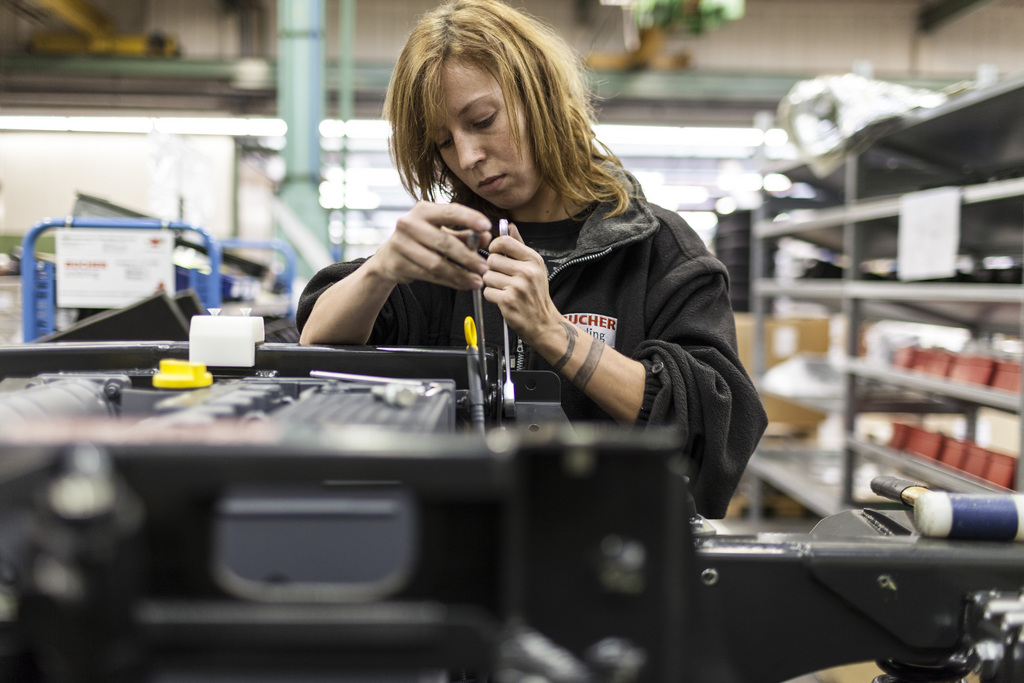Why jobs for the boys remain

You will rarely see a male primary teacher or a female computer programmer in Switzerland, as young people are still choosing what are deemed “male” or “female” professions. In an international comparison it came near the bottom in gender segregation.
One person bucking the trend is Niroja Velauthan, currently on a two-year information and communications technology (ICT) apprenticeship in Zurich with telecoms provider Swisscom.
“When I say that I am doing computing, most people are really surprised, I don’t know why that is. Perhaps they don’t think I look like a computer programmer,” says the neatly-dressed Velauthan, with a smile. Her enthusiasm is palpable.
“I was always very interested in this profession, even as a child. I started very early and taught myself web languages. I also have an uncle who really helped me and is still interested in what I am doing. I may be a woman, but I really enjoy this job,” the 22-year-old told swissinfo.ch.
The apprentice is one of three women in a class of 13 people. Betina Balitzki, Swisscom’s head of diversity, said there were 7% women in ICT at Swisscom, but that the company was trying hard, through various programmes, to encourage young women into the field.
“We also want more women engineers. But it’s very difficult because everybody else, the Googles, the Microsofts, also want more engineers and IT backgrounds so we are all looking in the same pool,” she said.
The Gender Inequalities in Educational and Career Pathways study was published on August 20, 2013. It is part of the National Research Programme “Gender Equality” (NRP 60).
Gendered professions were defined as occupations in which more than 70 per cent of the current workforce in Switzerland are either men or women; all other professions were considered gender neutral. In all, the career paths of 6,000 people were analysed over seven years and 33 in-depth interviews conducted.
An international study by Charles and Bradley in 2009 placed Switzerland pretty much at the bottom of the table for professional gender segregation, along with Finland, Hong Kong and South Africa. Colombia, Tunisia and Bulgaria had the least segregation.
The study said these results suggested a tendency for professional fields to be more segregated in more affluent societies. An apprentice-based education system also strengthens the segregation, according to Karin Schwiter, who worked on the Swiss study. Switzerland’s neighbours: Germany, France and Italy, did better than Switzerland but Germany, which also has a similar apprenticeship system, was also quite low on the list.
Exception
That Velauthan is an exception is borne out by research into professional gender segregation published in August by the Swiss national science foundation.
This was in turn inspired by an international study of 44 countries: not only did Switzerland come 44th in terms of the percentage of women going into mathematics or engineering, it also came 41st overall in terms of women going into masculinized fields of study and men into feminized ones. Colombia, Tunisia and Bulgaria were at the top of the list.
The Swiss study analysed the career paths of 6,000 young people who had left school in 2000. Around 1% aspired to gender atypical jobs at age 16 and actually worked in such a profession seven years later, said collaborator Karin Schwiter, from Basel University’s Center of Gender Studies.
Too early?
There are many reasons for this segregation, researchers found.
A key one is Switzerland’s education system, which forces young people to choose their job at age 14-15 – earlier than many other countries – when they have an especially narrow view of “suitable” jobs, Schwiter said.
“This means a young man would be thinking I should be a carpenter, electrician or roofer and women might think they could work in an office, be a florist or a nurse,” she told swissinfo.ch.
Gender atypical jobs don’t even appear on young people’s radars, even if they have special talents. Physics professor Ursula Keller is an exception.

More
High achieving woman
Family and career
Another reason is wanting to combine a family and career later on so some women might choose jobs where they can work part-time. Even if they don’t, it might be in the back of their mind.
“A female electrician in the study said it was her dream job, but if ever she wanted kids, she would have a problem: she couldn’t go to a building site with kids and you can’t work part-time because it’s always urgent,” said Schwiter.
“So she thinks, ‘maybe if I have kids, I’ll have to change to boring office work at an electrician’s’.”
Young men often opted for jobs where they could earn a good salary and support a family.
Peer pressure at age 14-15 is something Carla Mom is familiar with, as head of biz Oerlikon, one of seven career advisory services in canton Zurich. It is often more acceptable to do something out of the box at age 18 or 20, she said.
She rarely sees girls wanting to be carpenters or boys wanting to be nursery nurses, although there are more women going into painting and decorating – one of the less physically demanding areas of the building trade. “As soon as women join the profession, it becomes more acceptable,” she said.
Men might go into the care sector as a second career, added Mom.
From IT to teaching
This roughly tallies to Lars Herren’s experience. During a meeting after a day’s teaching, he explained that he worked in IT, and was a casino dealer, before finally settling, in his mid-thirties, for primary school teaching. In the third year of his studies at the Bern Teacher Training College, he would never have dreamed of being a teacher at age 15.
In most of his classes there are around 30 women and two men. There are about 5% -10 % men in the school where he works.
The low salary, a stressful start to the job and the fact that a lot of jobs are part-time are probably why lots of men are put off, Herren thinks.
“Probably a lot men find it a problem that there are more female teachers, but it’s not like that at all. You are well accepted as a man,” he said.
After compulsory education (currently 9 years, due to rise to 11), young people transfer to upper-secondary education.
This takes the form of either general education programmes to prepare for further education or vocational education and training (VET) to learn a profession. VET mostly involves an apprenticeship in a company combined with teaching at a VET school but can also be done in a full-time vocational school.
The majority of adolescents enroll in VET. Upper-secondary education is completed at the age of 18/19.
By 2015, the goal is to raise the proportion of people under the age of 25 who have successfully completed upper-secondary education from 90% to 95%.
(source: educa.ch)
Resources
Interestingly, the Swiss study found that young people going into gender atypical professions had above average school results in all areas and showed great self-confidence. Often their parents had a higher level of education.
Researchers have concluded that these young people often needed special resources to overcome existing preconceptions.
The study also emphasized the importance of encouragement by family members – as in Velauthan’s case with her uncle – as well as by teachers and vocational trainers.
More flexibility in the school system to allow for switching career more easily later on was also a recommendation. Labour market conditions also need to change, so more family friendliness and flexibility in the masculinized professions and better pay in the feminized ones.
What would those doing atypical jobs advise? “I think men should just do it,” said future primary teacher Herren. “It’s a big enrichment for your life when you see the kids every day.”
Velauthan is equally enthusiastic about her job in IT, which she describes as incredibly diverse. “You shouldn’t have the feeling that it’s a man’s profession, it’s also the perfect profession for women,” she said.

In compliance with the JTI standards
More: SWI swissinfo.ch certified by the Journalism Trust Initiative












You can find an overview of ongoing debates with our journalists here . Please join us!
If you want to start a conversation about a topic raised in this article or want to report factual errors, email us at english@swissinfo.ch.